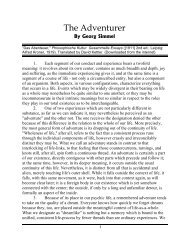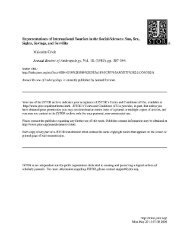The Maya Uay K'ot - OSEA-CITE
The Maya Uay K'ot - OSEA-CITE
The Maya Uay K'ot - OSEA-CITE
You also want an ePaper? Increase the reach of your titles
YUMPU automatically turns print PDFs into web optimized ePapers that Google loves.
V. Conclusion<br />
Like Lévi-Strauss (1963: 230), I believe that myths, at least some myths, contain<br />
their own incisive logic. <strong>The</strong>se stories offer a creative way of exploring conundrums that<br />
are seldom obvious to outsiders. At the same time, however, I think it would be wrong to<br />
reduce myth to a methodology for solving arcane puzzles. Speaking of commerce in the<br />
idiom of witchcraft suggests that there is more at stake than cracking unsolved mysteries,<br />
or explaining the opaque nature of capitalist exchange. It suggests that a judgment is<br />
being cast upon the morality of the marketplace and those who participate in it. Whereas<br />
institutions of bourgeois society attempt to make commodities enchant, the story of Way<br />
Kot presents commodity consumption as a form of cannibalism in which the rich eat the<br />
poor, or worse, in which unsuspecting <strong>Maya</strong>s eat their brethren. As the narrator in version<br />
one comments, the goods brought back by way kot are "pura lozas" (luxury goods), a<br />
devilish seduction that leads <strong>Maya</strong> villagers to participate in their own destruction.<br />
Indeed, by characterizing the tale as an historia the narrator indicates his awareness of the<br />
rhetorical/didactic function of the tale, not the veracity of every image or trope. Historias,<br />
as Sullivan notes, are “colorful and exciting, but they may contain truth, as well – lessons<br />
for present or future generations of ... common people” (1989: 186).<br />
<strong>The</strong> interpretation of Way Kot as a form of rhetoric – a counterpoint to the<br />
commodity aesthetics of the era – is strengthened by the concerns that other classes,<br />
including the peninsular elite, expressed about the growth of commerce. Protests from<br />
this quarter might appear ironic since the Yucatecan elite apparently had much to gain<br />
from the new economy; however, as Appadurai notes (1986: 33), “whereas merchants<br />
tend to be social representatives of unfettered equivalence, new commodities and strange<br />
tastes, political elites tend to be the custodians of restricted exchange, fixed commodity<br />
systems, established tastes and sumptuary customs”.<br />
Finally, I would argue that the reason Marx’s writing provides an effective<br />
vehicle for analyzing Way Kot is not because <strong>Maya</strong>s are in some sense proto-Marxists, or<br />
that peasant thought is governed by dialectical reason, but because Marxism itself is part<br />
of a rhetorical tradition – stretching from Aristotle to St. Thomas Aquinas and somewhat<br />
beyond – that not only emphasized the importance of labor, but questioned the value of<br />
the merchant and the money lender alike. As Block and Parry note (1989: 3), it “was<br />
essentially this idea of material production ... which prompted Tawney to remark that the<br />
‘true descendant of the doctrines of Aquinas is the labour theory of value. <strong>The</strong> last of the<br />
Schoolmen was Karl Marx’” (1972: 48). Here at last discussion of value as a moral<br />
precept catches up with value as an economic concept.<br />
Notes<br />
1 For example, Michael Taussig (1980) explains the significance of the devil pact in<br />
Colombia's Cauca Valley in terms of the alienation peasants experience upon becoming<br />
wage laborers for the first time. Unlike their fully proletarianized co-workers, who have<br />
become accustomed to the logic or illogic of the market, the newly proletarianized<br />
plantation workers are caught between two opposed productive systems and, therefore,<br />
experience first hand the disappearance of a more satisfying life, one in which “work,<br />
organically connects soul with hand” (1980:11). In an attempt to illustrate the nature of<br />
18




